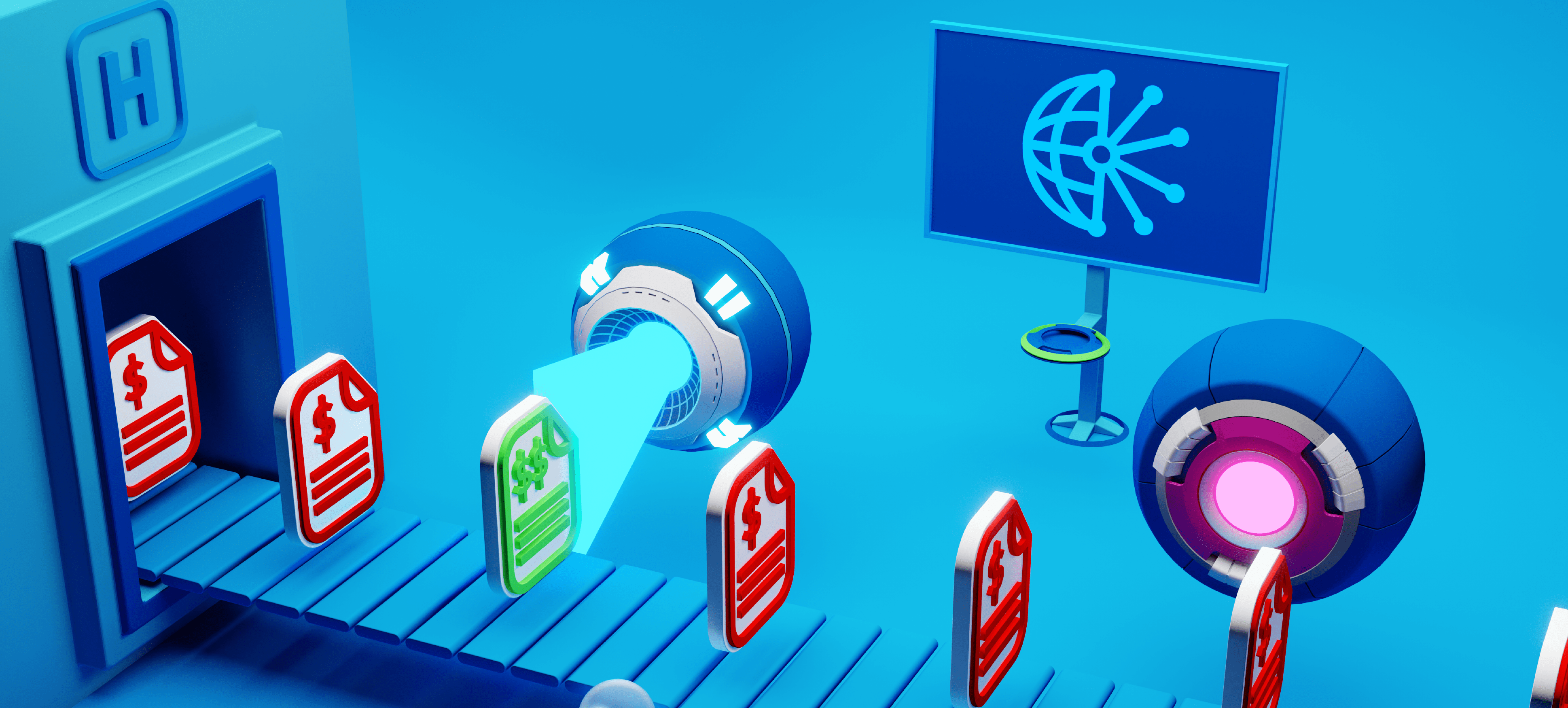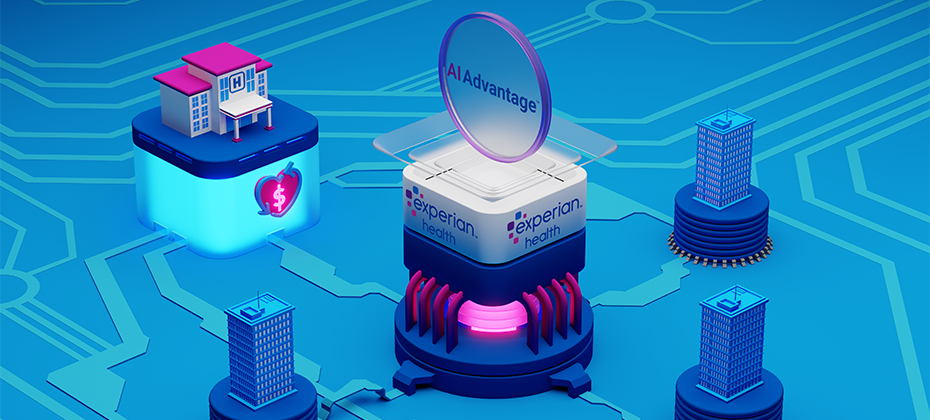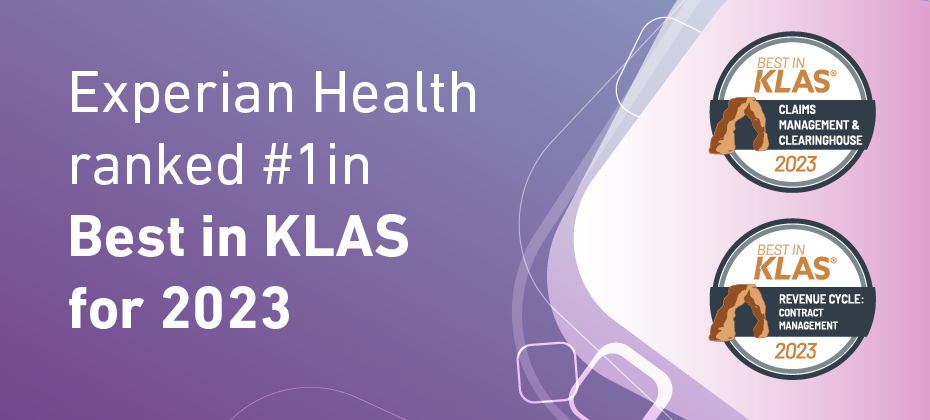Claims & Contract Management
Improve financial performance with automated, clean and data-driven medical claims management.

Could the era of manual claims processing be coming to an end? Experian Health's State of Claims 2022 survey revealed that more than half of healthcare providers have embraced advanced automation, freeing up staff from time-consuming and inefficient manual tasks. Automation has dominated as the key strategy used by providers to reduce denials in the previous 12 months. This evident optimism about technology's ability to address challenges in the claims process suggests that automation is here to stay. However, while automation has cracked open the doors to more efficient claims processing, the predictive power of artificial intelligence (AI) in claims processing can unlock exponentially higher rates of reimbursement. Providers may be increasingly aware of the benefits of automation, but many have yet to step into the world of AI. This article considers the advantages to be found in layering AI technology on top of automated claims processing and looks at how two new AI solutions are helping providers reduce denials and expedite payments. How automation helps with claims processing Healthcare organizations with automated claims processing report improvements in speed, accuracy, financial performance and patient experience. For example: Automated claims management solution ClaimSource® helped Hattiesburg Clinic in Mississippi accelerate cash flow, reduce denials to 6.1%, and expedite claims from secondary and tertiary payers. Summit Medical Group Oregon used Enhanced Claim Status and Claim Scrubber to reduce accounts receivable days by 15% and achieve a first-time pass-through rate of 92%. These tools improve efficiency across the entire claims cycle by automating repetitive tasks, executing effective workflows and generating data-driven insights into root causes of denials so staff can prioritize high-impact tasks and errors are far less likely. Industry reports corroborate these positive results: CAQH reports that the medical industry could save as much as $22.3 billion per year through further automation. Unlocking the untapped potential of AI in claims processing Despite automation's impressive results, claim denials remain a thorn in the side of many revenue cycle leaders. This is where AI can help, thanks to its ability to predict and respond to payer behavior and claims data. But while 51% of survey respondents were using automation, only 11% had introduced AI-based technology to their claims process. For the AI-curious, combining automation and AI could be a good starting point to supercharge claims processing. AI technology can predict potential issues before they even occur by analyzing claims and denials and making suggested corrections or interventions in real-time. It can also assist in identifying fraudulent claims and denials, leading to improved claims processing accuracy and revenue cycle management. By using automation and AI together, healthcare providers can gain better insights into their claims and denial data, resulting in improved financial performance and greater efficiency. What does that look like in practice? More efficient and accurate claims predictions Automation can relieve staff of manual data handling activities, increasing the speed and accuracy of claim processing, from patient intake through scrubbing, submission and adjudication. AI enables staff to perform remaining tasks with greater confidence and accuracy. They no longer need to wonder, “which claim should I rework first?” – AI has the answer. Without AI, the logical approach would be to rework what appear to be the highest-value denials first. But in many cases, these aren't the ones most likely to result in reimbursement. AI can help staff prioritize by analyzing historical payment data and undocumented payer adjudication rules to flag denials that are most likely to be paid. This is exactly how AI Advantage™ – Predictive Denials works. Experian Health's new AI-based solution checks for any changes to the way payers handle denials and assesses these against previous payment behavior. Providers can set their own threshold for the probability of denial, and if the solution determines that a claim will exceed this threshold, it alerts staff so they can act quickly and decisively before the claim is submitted. Schneck Medical Center was an early adopter of this tool and used it to complement their existing claims workflow (built around ClaimSource®). Within six months, they saw average monthly denials drop by 4.6%. Predictive alerts allowed staff to focus efforts on submitting clean claims the first time, so both the number of denials and hours spent reworking them were drastically reduced. “Learning” from denials data to drive financial performance By definition, automated claims processing systems will repeat the same tasks over and over. This is great for operational efficiency but has limited capacity to handle variation. A major advantage of an AI-based solution is its capacity to “learn” and predict, so each claim can be individually assessed and directed to the most appropriate workflow. AI Advantage™ – Denial Triage uses advanced algorithms to identify and intelligently segment denials so that providers can prioritize accordingly. Just as Predictive Denials uses historical payment data to predict the claims that may be at risk of rejection, Denial Triage learns from payers' past decisions to predict the denials that are most likely to be reimbursed if reworked. Read more about Schneck Medical Center's experience with AI Advantage. How does using AI benefit healthcare staff? The use of AI in claims management can be met with different reactions: some staff are enthusiastic about the prospect of having manual tasks taken off their plate and being able to use their time more effectively. Others may be concerned about the impact of AI on jobs and recruitment. The reality is that many providers face ongoing staffing shortages, and therefore have little option but to augment their existing teams with new technology. Maintaining pre-pandemic headcounts in light of post-pandemic work patterns and budgets may not be possible. Automation and AI can resolve these short-term challenges while generating a positive ROI in the long term, as the volume and complexity of claim denials continue to grow. As noted in the State of Claims 2022 report, technology should no longer be viewed as a threat to jobs, but as a way of making life easier for staff. Automation and AI work hand in hand to execute tasks that many staff find time-consuming and laborious, leaving the more stimulating and high-value tasks for the human workforce. Improving operational performance can therefore have a positive effect on job satisfaction and retention. The integration of AI in claims processing is not about replacing human expertise, but about harnessing the power of AI-powered algorithms to enhance efficiency and minimize denials. The optimal approach lies in combining the strengths of automation, AI and staff. Automation handles repetitive processes, AI expedites decision-making, and human expertise brings contextual understanding and empathy to the process. Learn more about how Experian Health can help organizations utilize AI in healthcare claims processing with AI Advantage.

Artificial intelligence (AI) is changing the healthcare industry. From disease detection to chatbots, AI is having a significant impact on the way healthcare providers operate and deliver care to patients. Additionally, AI is transforming the revenue cycle management process by automating tasks, such as claim denials management. By leveraging AI tools, healthcare providers can reduce the time and resources required for manual claims processing, ensuring that claims are paid faster and with greater accuracy. As claim denials continue to rise by 10-15%, healthcare organizations continue to grapple with the adverse effects on their finances. That's why Experian Health created AI Advantage™ – an innovative solution that helps providers with better claim denial management. The first component, AI Advantage – Predictive Denials, proactively identifies claims that are at high risk of being denied, so providers can edit the claim prior to submission. The second component, AI Advantage – Denial Triage, steps in after claims have been denied to identify those with the highest potential for reimbursement. Schneck Medical Center is one example of a healthcare organization that has seen significant results from implementing AI Advantage. After just six months, they successfully reduced denials by an average of 4.6% each month. Corrections that would previously have taken their organization 12 to 15 minutes to rework could now be processed in under 5 minutes. With AI Advantage, healthcare organizations can improve their claim denials management processes, increase efficiency, and reduce administrative costs. The solution's ability to prevent and reduce claim denials in real time can help healthcare providers maximize revenue while delivering high-quality patient care. As healthcare organizations continue to face mounting financial pressures and staffing shortages, AI-powered solutions will be increasingly important in helping them navigate these challenges and achieve long-term success. Learn more about how healthcare organizations can begin their journey towards improving efficiency and reducing claim denials with AI Advantage.

Because so many healthcare claim denials originate in the front end of the revenue cycle, providers should focus on improving insurance eligibility verification at the early stages of the patient journey. Verifying coverage earlier in the billing process with automated eligibility verification software increases the chance of submitting clean claims the first time and protecting future revenue. As coverage and benefits become more challenging for patients to navigate, prioritizing eligibility could also hold the key to better patient-provider relationships. Given the complexity of the healthcare billing system, patients have little tolerance for errors and delays. Many already worry about being able to cover their financial obligations, so denied claims are the last thing they want to see. Insurance verification reduces denials, gives patients greater clarity over their upcoming expenses and allows healthcare organizations to focus on providing the best possible care. This article looks at why improving insurance eligibility verification can help healthcare providers optimize cash flow and achieve higher levels of patient satisfaction and loyalty. What are the steps in the insurance eligibility verification process? Before filling out a claim, providers must be sure that the services they’re seeking reimbursement for are covered by the patient’s health insurance. They must also check that the patient’s details match those on their insurance plan. If a provider offers treatment or services and it later turns out that the patient’s coverage has expired or the patient is ineligible for those items, the claim will be rejected. To verify eligibility, providers must therefore be able to answer the following questions: Are the patient’s contact details current and correct? Does the patient’s insurance plan cover the planned treatment or services? Do any exclusions apply under the patient’s plan? Have all necessary pre-authorizations been obtained? Is the coverage active? What are the thresholds for deductibles, co-pays or coinsurance, and do any annual or lifetime limits apply? Confirming eligibility early on lays the groundwork for better claims management and minimizes the chance of errors. How does an effective eligibility verification system benefit patients and providers? Accurate and timely insurance verification clarifies to all parties how bills will be covered (or not) ahead of time. If a claim ends up being rejected, the patient will find themselves with responsibility for more of the bill, the provider will be left uncompensated for services rendered – or both. Clarifying coverage in advance avoids these scenarios. When providers can generate and communicate pre-service patient estimates with confidence, patients can plan for their bills and even make payments before or at the time of service. The financial benefits are clear, but patient satisfaction is also likely to increase: a study by Experian Health and PYMNTS found that patients who received pre-treatment estimates were more satisfied with their care than those who did not. Automated pre-service eligibility checks also improve communication between patients, providers and payers by reducing the manual workload on staff. Instead of spending time checking and fixing errors, staff can focus on helping patients with more complex cases. According to the CAQH, as much as $10 billion could be saved each year by switching to electronic eligibility and benefits verification. How does it help the claims process? In Experian Health’s report on the State of Claims 2022, the most common reasons given for claims being denied included: issues with prior authorizations, provider eligibility, patient information, changing payer policies and services not being covered. Automated eligibility verification helps solve each of these. With fewer errors in the pipeline, organizations can file claims faster and receive payments in a timelier manner. Eligibility Verification accesses up-to-date eligibility and benefits data from multiple sources, generating an instant read-out of a patient’s insurance status. More accurate information increases clean claims rates, accelerates reimbursement and allows providers to forecast future revenue levels more reliably. Staff can view responses in a clear and concise format and receive alerts when follow-ups or edits are required. This sets the tone for a more efficient claims process all around. Proactive and error-free claims management saves staff time that might otherwise be spent on reworking claims and engaging in lengthy disputes with payers. From the patient's perspective, earlier verification can fast-track registration because much of their information is checked before they even arrive for care. Waiting time is reduced because staff benefit from more streamlined workflows. As noted, finding missing coverage gives patients clarity over what they owe, so they’re more apt to pay bills on time. Automation can also be used to connect patients to the appropriate financial support. For example, with Patient Financial Clearance, providers can offer compassionate financial counseling and get patients on the right financial pathway. It improves the patient experience while reducing the risk of bad debt. What does a good insurance eligibility verification system look like? When it comes to choosing an insurance eligibility verification solution, the checklist should include the following features: Compatibility with existing systems and electronic health records - Eligibility Verification accelerates verification and registration by drawing together accurate patient data. And through eCare NEXT®, clients can manage multiple patient access functions through a single interface. Simple methods for updating or changing patient information - User-friendly interfaces allow staff to make changes from any device, as and when new information arises. Integration with patient portals means patients can spot errors themselves, too. And tools such as Registration QA can drive data accuracy by highlighting errors as soon as they occur, both pre-and at the point of service. Rapid results, with patient benefits information readily available when needed - Eligibility Verification confirms patient eligibility and calculates reimbursement estimates with precision. This incorporates CAQH COB Smart® data for enhanced coordination of benefits in relevant transactions. Ability to calculate patient estimates - A verification tool that integrates with automated patient payment estimates ensures patients understand their coverage, co-pays and deductibles before treatment proceeds so that they can plan for their final bills. Integration with pre-authorization tools - For some services, a payer may require the provider to seek authorization before going ahead. An insurance verification solution can flag up where prior authorization is needed to prompt action and prevent delays. Ability to source data from major health insurance carriers, including Medicare - Eligibility Verification connects with nearly 900 payers with advanced search functionality to match patients to current eligibility and benefits data. This can be used alongside an optional lookup service for Medicare beneficiaries to find and validate MBI numbers. Ongoing changes to the health insurance landscape mean that providers must pay close attention to the process of verifying coverage and benefits. Although insurance verification is a small step in patient access, the impact can be felt throughout the patient’s journey and the provider’s revenue cycle. By optimizing for earlier and more accurate insurance verification with workflow automation and advanced data analytics, providers can reduce the risk of denied claims, improve financial performance and protect patient-provider relationships. Find out more about how Experian Health can help healthcare providers streamline their claims process with front-end improvements to verify insurance eligibility, file error-free claims and get paid faster.

“The challenge we sought to overcome by leveraging AI Advantage at our organization was just gaining more insight into how denials originate and what actions we can take to prevent those from happening.” — Skylar Earley, Director of Patient Financial Services, Schneck Medical Center Challenge Starting as a 17-bed hospital more than 100 years ago, Schneck Medical Center now serves four counties in Indiana, with a staff of more than 1,000 employees, 125 volunteers and nearly 200 physicians. The organization’s vision is to deliver excellence, lead transformation and advance health, underpinned by a patient-first philosophy. For the Patient Financial Services team at Schneck Medical Center, reworking denied healthcare claims was often time-consuming and inefficient. Billers tended to prioritize high-value claims, without knowing the probability of reimbursement. They sought a denial management solution that would reduce the risk of denied claims and minimize their impact on the revenue cycle. Solution Schneck worked with Experian Health to test two new denial management solutions that use artificial intelligence (AI) to reduce the likelihood of denials and prioritize rework to maximize reimbursement. The first, AI Advantage™ – Predictive Denials, uses AI to predict claims that have a high chance of being denied, so they can be corrected before the claim is sent to the payer. If a claim review exceeds the suggested threshold for denial probability, an alert is triggered, and the flagged claim is automatically routed to the appropriate biller. The biller investigates the alert to understand what changes are needed. This might include checking insurance eligibility, reviewing coding errors or reviewing authorization status. Once the alert is resolved, the claim can be automatically resubmitted. The second solution, AI Advantage™ – Denial Triage, prioritizes denials based on the potential for reimbursement so staff can focus recovery efforts on the right claims. The triage process starts with identifying between 2 and 10 denial segmentation categories based on likelihood of reimbursement. Schneck chose to identify 5 categories to start. Individual remits are evaluated and automatically assigned to the appropriate category, so they can be routed to the correct specialist. The tools use historical claims data and a continuously learning AI model to detect patterns in payer decisions. Staff can customize denial probability thresholds and segmentation criteria to ensure claims are routed to the correct specialist. The solutions integrate seamlessly with Schneck’s existing claims management system, ClaimSource®, and other health information workflows. Outcome After just six months, AI Advantage helped Schneck reduce denials by an average of 4.6% each month. Corrections that would previously have taken 12 to 15 minutes to rework can now be processed in under 5 minutes. Staff report that the thresholds determined by AI Advantage – Predictive Denials are highly accurate, leading to better decision-making when reworking claims prior to submission. And with AI Advantage – Denials Triage, staff feel confident that they’re focusing their attention on the right segments, rather than wasting time on high-value claims that are unlikely to be reimbursed. Skylar Earley says, “Before, we had no insight into whether we were performing value-added work when we followed up and worked denials. Now we see those percentages.” Learn more about how AI Advantage generates insights to help healthcare organizations reduce time spent working denials and maximize reimbursement.

Healthcare is undergoing a digital revolution driven by artificial intelligence (AI) and machine learning (ML) technology. While some organizations have been slow to adapt, others incorporated new solutions that have helped their organization identify patterns, reduce claim denials, and more. This infographic breaks down common phrases related to artificial intelligence and machine learning so that healthcare organizations can understand what they mean and how they're utilized. Introducing: AI Advantage™ Experian Health is the top-performing claims management vendor, according to the 2023 Best in KLAS: Software and Professional Services report. Experian Health’s ClaimSource® solution, an automated, scalable claims management system designed to prevent claim denials, ranked number one in the Claims Management and Clearinghouse category. With denials and staffing shortages on the rise, an efficient claims management strategy is essential. Experian Health is here to help with AI Advantage™ – a new solution that utilizes true artificial intelligence that proactively helps reduce denials and, when necessary, identifies the best denials to resubmit.

Experian Health is very pleased to announce that it ranked #1 in Best in KLAS, Software and Professional Services, for two segments: #1 in Claims Management and Clearinghouse, for our ClaimSource® claims management system #1 in Revenue Cycle, Contract Management, for our Contract Manager and Contract Analysis product. According to KLAS CEO Adam Gale, “The 2023 Best in KLAS report highlights the top-performing healthcare IT solutions as determined by extensive evaluations and conversations with thousands of healthcare providers. These distinguished winners have demonstrated exceptional dedication to improving and innovating the industry, and their efforts are recognized through their inclusion in this report. Congratulations to all the winning vendors for setting the bar for excellence in healthcare IT! KLAS continues to be committed to creating transparency and helping providers make informed decisions through our accurate, honest, and impartial reporting.” Experian Health’s 2022 State of Claims survey reveals that 47% of providers said that improving clean claims rates was one of their top pain points, with 42% reporting that denials have increased in the past year. Read how Hattiesburg Clinic in Mississippi, which uses both Contract Manager and Analysis and ClaimSource, leverages ClaimSource to automate claims management and reduce denials. Learn more about how ClaimSource and Contract Manager and Contract Analysis can help your healthcare organization.

The consequences of failing to properly verify patient insurance eligibility can wreak havoc on the healthcare revenue cycle. Incorrect patient information, expired policies and missing pre-authorizations can all contribute to denied claims and delayed payments. But with patients bearing a greater responsibility for the cost of care and switching health plans more often, verifying eligibility has become more complex. As patient volumes grow, manual verification processes are increasingly vulnerable to errors. Health insurance eligibility verification software helps providers solve this problem. Few things are more frustrating for healthcare leaders than costly denials that could have been avoided. In a survey by Experian Health, one in three healthcare executives said claims are denied 10%–15% of the time, costing billions of dollars in lost revenue. An automated solution that eliminates errors and reduces denials could pay big dividends across the revenue cycle. This article breaks down the key revenue-boosting benefits of health insurance eligibility verification software: What is eligibility verification? Eligibility verification is the process of checking that a patient’s insurance information is correct and that the services they are seeking are covered under their existing plan. Providers are responsible for verifying the patient’s enrollment status before offering care. Once active enrollment is confirmed, providers will also need to verify the benefits included in the patient’s plan, to be sure that the cost of specific services and items will be covered. This involves the following steps: Checking the patient’s identity and contact information and ensuring that the details on their insurance card match their electronic health record Determining whether the patient’s insurance plan covers the services they expect to receive and that no exclusions apply Confirming that the patient is eligible for proposed services or treatment, for example by ensuring that any pre-authorization or referral requirements have been fulfilled Double-checking that the patient’s coverage is active and that they haven’t exceeded any annual or lifetime limits. "If providers don’t have a full picture of the patient’s payable benefits, deductibles, co-pay thresholds out-of-pocket maximums, and other policy details, they run the risk of non-reimbursement," says Kate Ankumah, Product Manager at Experian Health. "For that reason, these checks should be carried out before a patient’s appointment or procedure, to prevent awkward billing issues and delayed payments. This gives providers peace of mind that they’ll be reimbursed for the services they provide and accelerates patient registration." Carrying out these checks manually can be a time-consuming and laborious process. Staff must check individual payer websites and portals or phone insurance companies to get hold of the necessary information, all while speaking to the patient. Batch processing by medical claims clearinghouses can be a more efficient way of managing eligibility checks, though individual accounts may take longer to clear. What are the benefits of using health insurance eligibility verification software? Given the scale and impact of eligibility checks, many providers turn to insurance verification software to streamline the process and achieve higher levels of accuracy. This offers several benefits to providers and patients: Reduced risk of bad debt - In the world of healthcare claims, errors are expensive. Eligibility verification software can pull from multiple data sources at the click of a button, to give an instant and accurate read-out of a patient’s current insurance details and identity information. Reliable data helps prevent billing errors, thus reducing the risk of disputes with insurance companies. Providers are less likely to bill for services that aren’t covered by the patient’s insurance. Improved patient experience - Billing errors and delays are also major sources of stress for patients. The mismatch between estimated and actual costs is a common complaint. With 3 in 10 patients feeling unable to pay a $500 bill, providers must take steps to provide clarity around the billing process. Automated pre-service eligibility checks help to inform patients of their financial obligations so they can plan accordingly. The software can also support the delivery of tailored, proactive communications to patients, to avoid misunderstandings and queries. Patients are more satisfied with their overall payment experience, while providers see fewer payment delays. Increased revenue - The cost of eligibility errors goes beyond revenue lost through claim denials. If a patient’s insurance information isn’t checked properly, providers bear the financial burden of productivity losses, delayed patient payments, and reputational damage. Eligibility verification software can root out potential mistakes lurking beneath the surface so that claims and communications are correct the first time. By minimizing denials and helping to find missing coverage, this software maximizes reimbursement and accelerates payments. Optimized operations - As noted, using eligibility verification software instead of manual processes can result in significant productivity and efficiency gains. The CAQH reports that electronic eligibility and benefits verification could save medical providers 21 minutes per transaction, amounting to a potential cost saving of nearly $10 billion per year. Automation can release staff from time-consuming calls to insurance companies, reducing their workload and freeing them up to help patients with more complicated needs. This creates a positive patient experience while easing the pressures of staffing shortages. By improving overall revenue cycle management, verification software can increase financial stability. Key features to look for when choosing insurance eligibility verification software By now, most providers will be familiar with automation’s promise of speed, efficiency and accuracy. To fully capture these benefits, providers should choose a software solution with certain key features. Real-time updates allow providers to confirm patient eligibility instantly, without falling foul of any changes to the patient’s coverage that could hamper reimbursement. For example, Experian Health’s Insurance Eligibility Verification solution connects with over 890 payers so providers can access up-to-the-minute eligibility and benefits data. Optimized search functionality increases the likelihood of finding a patient match. An optional Medicare beneficiary identifier (MBI) lookup service finds and validates MBI numbers, ensuring timely reimbursement, which is especially important as COVID-19 funding comes to an end. Next providers should look for a user-friendly interface. Insurance Eligibility Verification adapts responses from multiple payers so that registrars can access patient details in a consistent format, regardless of the original layout. Customizable alerts notify staff when action is needed. A major advantage of automated solutions lies in the possibility for more detailed reporting and analytics. A tool that synthesizes performance data can provide at-a-glance status updates for senior managers and help staff identify opportunities for improvement. Similarly, providers should look for a tool that fits neatly with their existing electronic systems and interfaces, to fully leverage data analytics and streamline operations. Integration with electronic health records can fast-track verification and registration by providing a single source of truth regarding patient information. Existing Experian Health clients will be able to access Eligibility Verification through eCare NEXT®, providing a single interface from which to manage several patient access functions. Automated verification: a smart investment? Rachel Papka, Director of Health Systems at Steinberg Diagnostic Medical Imaging says Experian Health’s eligibility products have helped her team to validate patient coverage in under 30 seconds: “The Eligibility and eCare NEXT piece allows us to see if the patient is eligible with the insurance they just presented quickly and in real-time – in under 30 seconds. As I'm facing the patient, I'm not hiding behind a phone. I'm not trying to log on to a different website. I'm literally interacting with the patient at the time of service with the eCare NEXT platform, and it's telling me their deductible or coinsurance or co-payments, and I can accurately collect from that patient right there. And it directly writes into my electronic medical record, so users only need to use one system.” For the 3 in 4 healthcare executives who said reducing denials was their top priority, automated insurance verification could be a wise investment. Find out more about how Experian Health’s health Insurance Eligibility Verification software could hold the key to streamlined claims management, fewer denials and faster cash flow.

Hattiesburg Clinic is Mississippi’s largest multispecialty clinic with over 450 physicians serving 19 counties. Claims management, patient collections and payer contract management are handled by the clinic’s Financial Services Department, which includes around 70 staff members. Challenge Hattiesburg Clinic in Mississippi sought to improve financial performance in the wake of the COVID-19 pandemic by focusing on reducing claim denials. The Financial Services Department had been hit by staffing shortages, which affected financial results. A more efficient digital claims management solution would attract and retain a high-performing virtual team, while supporting the shift away from existing paper-based systems. To submit more clean claims the first time, the Department set specific goals to: meet or exceed Epic benchmarks for primary denials maintain accounts receivable (AR) days at 42 or less process secondary and tertiary claims without waiting for the primary electronic remittance advice (ERA) to be posted. Solution Already impressed with Experian Health’s Contract Manager and Eligibility solutions, the Department chose another Experian product, ClaimSource®, to help reduce denials. Loretta McLaughlin, Assistant Director of Financial Services, said she was confident ClaimSource was a good candidate for the clinic’s claims platform: “ClaimSource seemed like the right fit for the department’s goals. The platform’s ability to customize edits, along with the level of customer support available, really set the solution apart from the alternatives.” ClaimSource uses scalable automation to prioritize claims, payments and denials. This allows staff to use their time as efficiently as possible, by working on the highest-impact accounts first. Using customizable edits and extensive national and local payer edits, it checks each claim for inconsistencies before the claim is submitted. ERA data is automatically integrated into Epic so that staff can check a claim’s status quickly and easily. With real-time reporting, staff gets insights from across the entire claim lifecycle to improve performance. Outcome The ability to integrate customizable edits was a big advantage for the clinic. They now have over 90 custom edits that help eliminate time-consuming errors, reduce denials, and allow staff to focus on the right accounts. As a result, Hattiesburg Clinic has achieved a 6.1% primary denial rate, which exceeds the Epic Financial Pulse benchmark. Despite staffing shortages, they’ve been able to accelerate receivables. They’re also seeing accelerated cash flow, now they can pursue claims from secondary and tertiary payers without awaiting the outcome of primary claims adjudication. ClaimSource is also creating a better staff experience: the tool eliminates the need for claims to be printed, so staff can work from any location. Now, over 50% of the team work from home. Thanks to automated workflows, output has been consistent despite a reduced workforce. Being able to submit clean claims the first time has a positive impact on AR days as well as staff workload. Loretta McLaughlin says: “Through ClaimSource’s automation and level of quality work, we have had to do less manual intervention.” To build on this success, the team intends to explore further opportunities to use automation to improve productivity. Options include automatically generating patient estimates, automating bad debt and refund workflows, and allowing patients to verify insurance eligibility through their patient portals. Find out more about how ClaimSource helps hospitals, health systems and physician groups reduce denials, protect profits and increase productivity through automated and scalable claims management.

In 2009, processing claims was listed as the second greatest contributor to “wasted” healthcare dollars in the US, at an estimated $210 billion. A decade later, that amount was estimated at $265 billion. Today, healthcare providers are still grappling with denied healthcare claims, with both challenges and solutions accelerated by the pandemic. To put the scale of operational and delivery changes into perspective, Experian Health recorded well over 100,000 payer policy changes for coding and reimbursement between March 2020 and March 2022. The implications for claims processing are immense, which is why healthcare providers need to reevaluate their denial management strategies and invest in new technology that can help increase reimbursements. In June 2022, Experian Health surveyed 200 revenue cycle decision-makers to understand how they feel about the current situation. What are the priorities of those on the front line of denials management? And how can technology contribute to improvements? This article breaks down the key findings. Takeaway 1: Denials are increasing and reducing them is priority #1 30% of respondents say denials are increasing by 10-15% Nearly 3 out of 4 respondents say that reducing denials is their top priority For most respondents, claims management is more important now than it was before the pandemic, because of payer policy changes, reimbursement delays and increasing denials. Respondents attribute this to insufficient data analytics, lack of automation in the claims/denials process and lack of thorough staff training. When it comes to improving denial rates, staffing seems to be the greatest challenge. More than half of respondents say staff shortages are slowing down claims submissions and hampering efficiency. Shrinking offices mean there is less staff to handle the growing volume and complexity of claims. It’s no surprise, then, that around 4 in 10 respondents are also concerned about keeping up with rapidly changing payer policies and keeping track of pre-authorization requirements. Providers recognize that technology can help reduce denials while easing the burden on staff. A tool like ClaimSource manages the entire claims cycle using customizable work queues that make it easy to prioritize accounts, saving staff time and avoiding the errors that lead to denials. This also incorporates payer edits to ensure that claims are clean before being submitted to the payer. And if claims do end up needing further attention, Denials Workflow Manager eliminates time-consuming manual processes and allows providers to attend to high-risk claims quickly, so there’s less chance of delayed reimbursement. Takeaway 2: Automating denials management in healthcare is critical 52% of respondents upgraded or replaced previous claims process technology in the last 12 months 51% are using robotic processes, including automation, but only 11% are using artificial intelligence Prior to the pandemic, automation was sometimes perceived as a threat to jobs. But with changing employment patterns and evidence of the broader benefits of automation, attitudes are shifting. Automation can make life easier for staff by removing manual tasks to allow them to focus on other priorities. It speeds up the healthcare claims processing workflow, reduces the risk of errors, and enables better communication between providers, patients and payers. Providers recognize that automation drives more efficient claims management. The survey revealed that 45% of respondents turned to automation to keep track of payer policy changes, 44% had automated patient portal claims reviews, and 39% had digitized patient registration in the last year. Automation supports all stages of the claims management process, from auto-filling patient data during registration, to generating real-time claim status reports for back-office staff. Payer authorizations were a common challenge for providers, and a perfect fit for automation. Experian Health’s Prior Authorizations solution eliminates the need for staff to visit multiple payer websites, automates inquiries, and offers real-time updates on pending and denied submissions so staff knows when to intervene. Takeaway 3: Providers are searching for denial management solutions that will achieve the greatest ROI 91% of those likely to invest in claims technology say they will replace existing solutions if presented with a compelling ROI The majority of providers may be on the lookout for better claims management solutions, but they vary in how they measure ROI. Predictably, one of the most common metrics is how much staff time can be saved, with 61% concerned with hours spent appealing or resubmitting claims, and 52% looking at time spent reworking claims versus reimbursement totals. Rates of clean claims and denials were also popular metrics, at 47% and 41%, respectively. Using Denials Workflow Manager and ClaimSource alongside additional claims management solutions like Claim Scrubber and Enhanced Claim Status can deliver an even stronger performance against the above metrics. Each solves a specific challenge within the claims management workflow, but when used together, the ROI is multiplied. Overall, there’s optimism that digital technology and automation can help healthcare providers improve claims and denial management and reduce the amount of “wasted” dollars. This survey shows that providers are keen to grasp the opportunities offered by automation to optimize the reimbursement process and get paid sooner. Download the report to get the full results on the State of Claims 2022, and discover how Experian Health can help organizations with their denial management strategies.